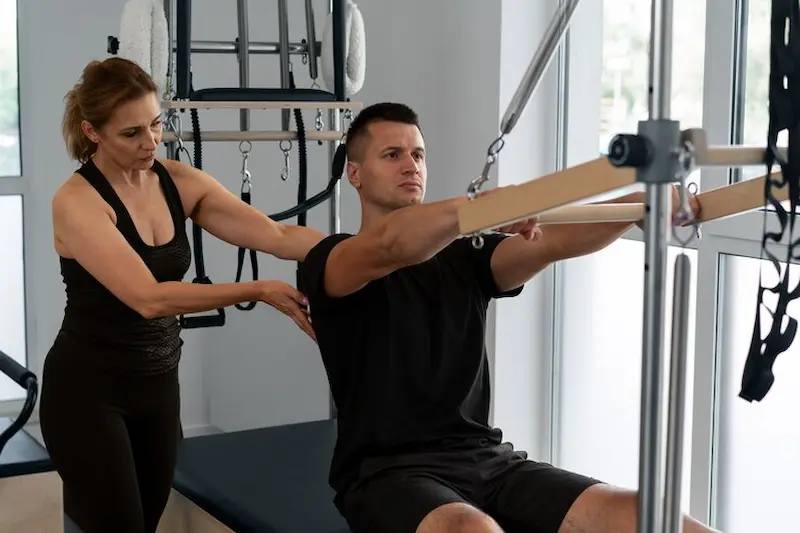What are the 4 pillars of fitness? Fitness is not a one-dimensional concept; it encompasses various aspects that contribute to overall well-being. To achieve true fitness, you need to focus on more than just physical strength. In this comprehensive guide, we will delve into the four pillars of fitness, shedding light on each one’s significance and how they collectively shape a healthier and happier you.
Physical Fitness


Physical fitness is often what comes to mind first when discussing fitness. It involves aspects like cardiovascular health, muscular strength, endurance, and flexibility. Regular exercise, such as cardio workouts, strength training, and stretching exercises, plays a vital role in achieving physical fitness. Additionally, maintaining a balanced diet rich in nutrients fuels your body for peak performance.
Mental Fitness


Mental fitness is the foundation of overall well-being. It encompasses cognitive abilities, emotional intelligence, and psychological resilience. Engaging in activities like meditation, mindfulness, and brain-training exercises can improve mental fitness. Managing stress, developing healthy coping mechanisms, and seeking support when needed are key components of this pillar.
Nutritional Fitness


Nutritional fitness emphasizes the importance of a well-rounded diet. Consuming a variety of nutrient-dense foods ensures your body receives the vitamins, minerals, and energy it needs. Understanding portion control, meal timing, and macronutrient balance can help you achieve nutritional fitness. Proper hydration is also a crucial aspect of this pillar.
Social Fitness


Social fitness highlights the significance of healthy relationships and a supportive social network. Building meaningful connections, fostering communication skills, and nurturing positive relationships contribute to social fitness. Engaging in social activities, volunteering, and seeking emotional support from loved ones are ways to enhance this dimension.
The Interplay of the Pillars
Achieving overall fitness is not about isolating these pillars but recognizing their interconnectedness. Physical fitness can boost mental clarity, and a healthy mind can motivate you to maintain proper nutrition. Likewise, strong social bonds can provide emotional support during your fitness journey.
Setting SMART Goals
Setting Specific, Measurable, Achievable, Relevant, and Time-bound (SMART) goals is essential in each fitness pillar. Whether it’s running a marathon, reducing stress, improving your diet, or building stronger relationships, clear objectives make your fitness journey more manageable.
Building a Holistic Fitness Routine
A well-rounded fitness routine should encompass activities that address all four pillars. Incorporate cardiovascular exercises, strength training, mental wellness practices, and social activities into your weekly schedule for comprehensive fitness.
Overcoming Challenges
Every fitness journey encounters challenges. Whether it’s overcoming physical limitations, managing stress, refining your diet, or improving social skills, resilience and determination are your allies in addressing these hurdles.
Seeking Professional Guidance
Sometimes, achieving balance across the four pillars may require expert advice. Consider consulting with fitness trainers, nutritionists, mental health professionals, or relationship counselors to ensure you’re on the right path.
Celebrating Success
Regularly assess your progress in each fitness pillar and celebrate your achievements. Recognizing milestones, no matter how small, can provide motivation to continue your journey toward holistic fitness.
Conclusion:
By understanding and nurturing the four pillars of fitness—physical, mental, nutritional, and social—you can embark on a transformative journey toward a healthier and more fulfilling life. Remember that achieving balance across these dimensions takes time and effort, but the rewards in terms of improved well-being are immeasurable. Embrace this holistic approach to fitness, and you’ll discover the true power of a well-rounded lifestyle.
| ALSO READ: |
| | How to Lift Your Mood: 10 Science-Backed Ways to Feel Better |
| | Master the Art of Speaking with a Deeper Voice in Just 5 Easy Steps |
| | 10 ways How to Balance Your Life as a Working Mom |
What are the 4 pillars of fitness?
FAQ
Q1: What is the significance of physical fitness within the four pillars of well-being?
A1: Physical fitness is essential because it forms the foundation for overall well-being. It includes cardiovascular health, muscular strength, endurance, and flexibility, ensuring that your body can perform at its best in various aspects of life.
Q2: How can one improve their mental fitness?
A2: Mental fitness can be enhanced through activities like meditation, mindfulness, brain-training exercises, and stress management. Developing emotional intelligence and seeking support when needed are also key components.
Q3: What role does nutritional fitness play in overall health?
A3: Nutritional fitness is vital as it provides the body with essential nutrients for optimal functioning. A balanced diet supports physical and mental health, and proper hydration is equally important.
Q4: How can individuals improve their social fitness?
A4: Social fitness involves building meaningful connections, fostering communication skills, and nurturing positive relationships. Engaging in social activities, volunteering, and seeking emotional support contribute to social well-being.
Q5: How do these four pillars of fitness interact with each other?
A5: The pillars of fitness are interconnected. For example, physical fitness can improve mental clarity, a healthy mind can motivate better nutrition, and strong social bonds can provide emotional support during fitness journeys.
Q6: What are SMART goals, and why are they important in fitness?
A6: SMART goals are Specific, Measurable, Achievable, Relevant, and Time-bound objectives. They provide clarity and direction in achieving fitness goals across all four pillars.
Q7: How can individuals build a holistic fitness routine?
A7: A holistic fitness routine should include cardiovascular exercises, strength training, mental wellness practices, and social activities. Balancing these activities ensures comprehensive well-being.
Q8: What strategies can be employed to overcome challenges in the pursuit of holistic fitness?
A8: Resilience and determination are essential. Identifying challenges, seeking support, and adapting your approach when necessary are effective strategies.
Q9: When should individuals consider seeking professional guidance for their fitness journey?
A9: Seeking professional guidance is advisable when faced with specific challenges or when you need expert advice on improving aspects of physical, mental, nutritional, or social fitness.
Q10: Why is it important to celebrate successes in each fitness pillar?
A10: Celebrating successes, regardless of their size, provides motivation and reinforces positive behaviors. It acknowledges progress and encourages individuals to continue their journey toward holistic fitness.

